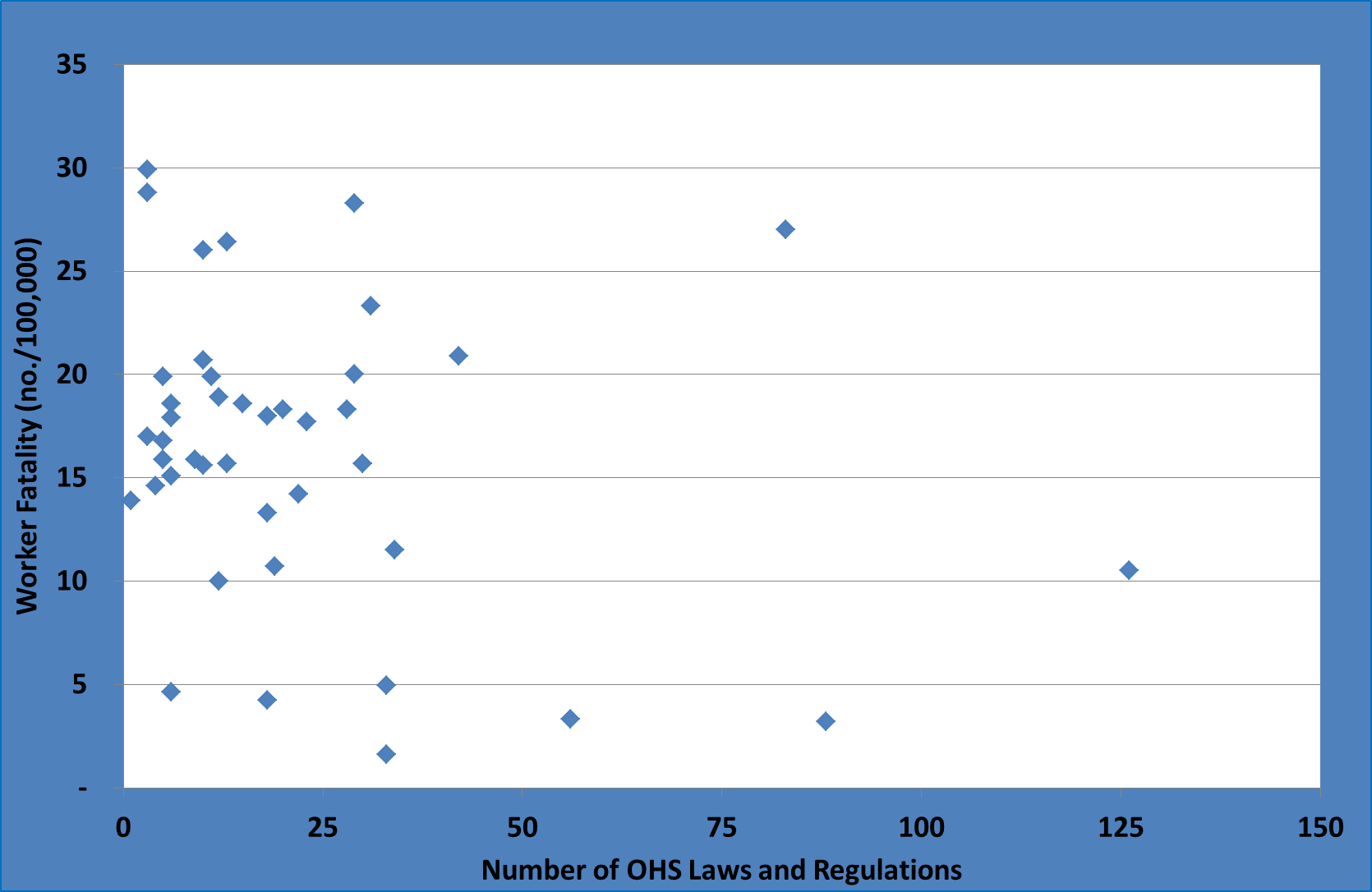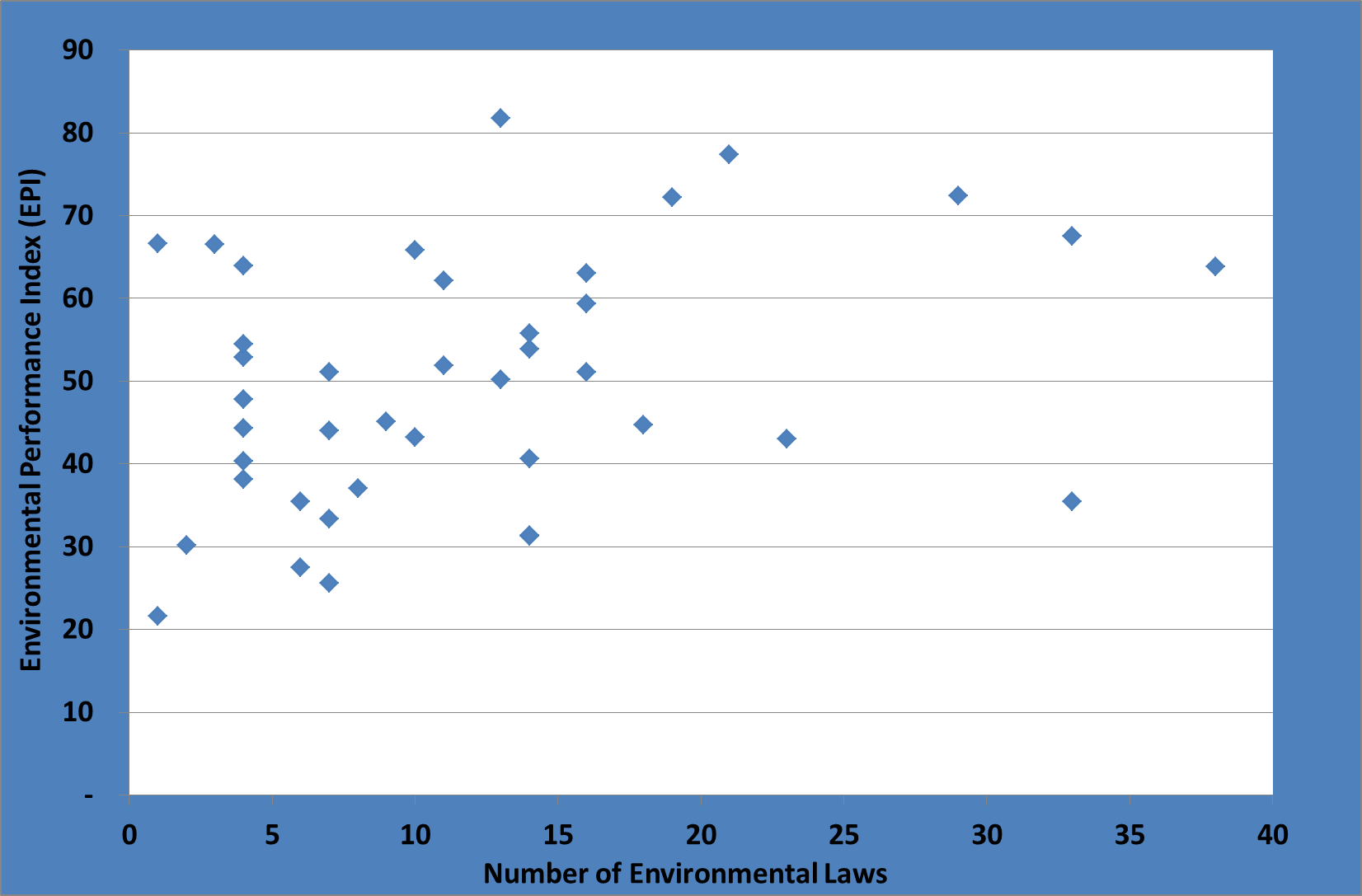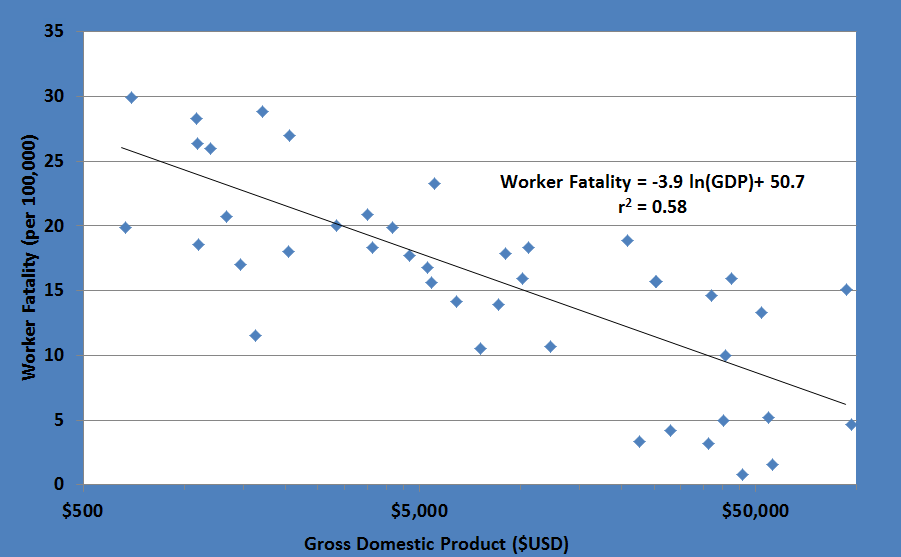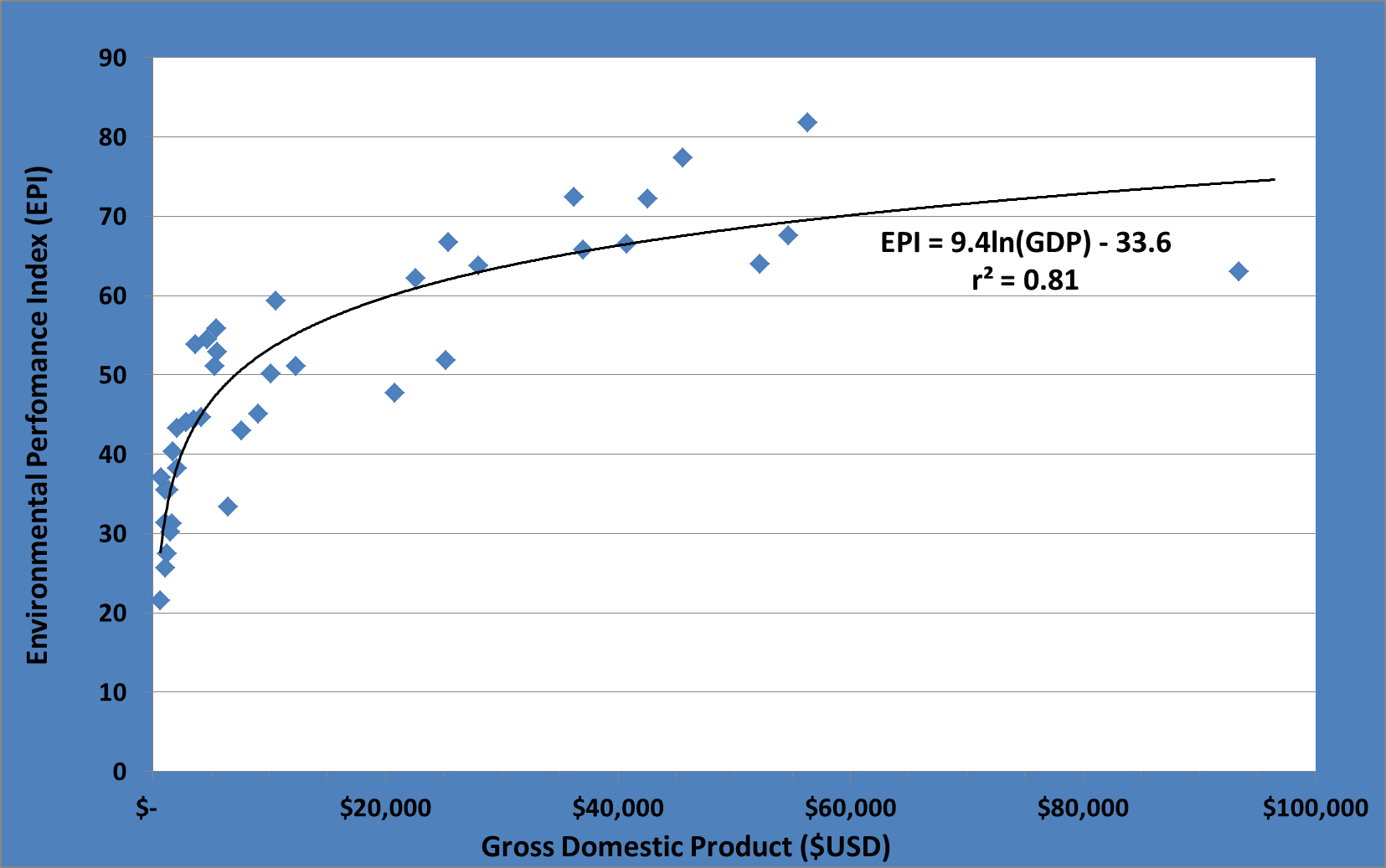In the last several blog posts I have presented an overview of national and international occupational health and safety (OHS) and environmental laws and regulations that affect companies operating in Asia.
I noted that there was no significant correlation between the complexity or maturity of a country's national HSE legislative regime and improvements to either worker health & safety or environmental performance, at least as measured by worker fatality rates and Environmental Performance Index (EPI), respectively:
Figure 1: Worker Fatalities vs Number of OHS Laws and Regulations in Asian Countries

Figure 2: EPI vs Number of Environmental Laws in Asian Countries

At the same time, strong significant correlations were noted between country wealth, as measured by Gross Domestic Product (GDP), and these same HSE performance indicators:
Figure 3: Worker Fatalities vs GDP in Asian Countries

Figure 4: EPI vs GDP in Asian Countries

Correlation does not necessarily imply causation, so we must be careful when interpreting these data. But, at first glance, this does suggests that (1) HSE laws and regulations may not be effective and (2) gains in HSE performance are at least partly a result of increased prosperity, not HSE legislation.
Is this really true? Let’s dive into some of the published literature and try to figure this out.
Are HSE Laws and Regulations Effective?
This is an interesting and important issue and also one that has received a significant amount of attention from academics and others over the last 40 years.
One of the earliest studies on this topic was done by W. K. Viscusi, who analyzed data collected for a four-year period following the passage of the US Occupational Health and Safety Act (OSHA) in 1970. He concluded that there was no significant OSHA impact on industry health and safety investments and injury rates.
Over the years, others have looked at this issue in a variety of settings in both developed and developing countries and it appears to me that most authors have arrived at the same general conclusion. For example, Pringle et al (2003) recently studied this issue in China and stated that “despite the promulgation of new laws, it is clear that Chinese workers still face major barriers to workplace safety”.
The situation with respect to the impact of environmental laws and regulations is similar.
A World Bank study conducted in 1996 in collaboration with environment agencies in six major developing countries, namely Brazil, China, India, Indonesia, Mexico and the Philippines, revealed that environment-based policies in these countries had been centered on legislation as a means of environment protection. That study also revealed that experience in these countries showed the laws on environment as being ineffective and that manifold problems were barring the operation of environment agencies and offices concerned in these countries. According to El-Gundy, the situation in Arab countries in 2008 was not much different from that in the six countries of the 1996 World Bank study.
In a detailed review of the recent situation in China, it was noted that “although China has constructed an expansive environmental law framework over the past 30 years, implementation of laws and regulations in practice has been notoriously weak. A leading Chinese environmental law scholar put the problem bluntly: “China’s green laws are useless”.
I must point out that there are examples of where HSE laws and regulations have been very successful, e.g., Montreal Protocol for ozone depletion. To be clear, I am not saying that all HSE laws and regulations are useless, but simply pointing out that the empirical evidence does suggest that laws and regulation are much less effective than we might want to believe.
As you can probably guess, lack of effective enforcement is part of the problem, but there are also many other factors to consider. In next week’s blog post I will discuss reasons why HSE laws are generally ineffective.
Increased Prosperity Equals Improved HSE Performance
That increased wealth is correlated to improved HSE performance is not at all surprising. This is easily observed by anyone that has had a chance to work globally - the occupational safety situation and environmental quality in developed countries is generally better than that of developing countries.
This is supported by worker safety by data from the ILO; the fatality rate in advanced industrialized economies is almost half that of Central and Eastern Europe, China and India. In the Middle East and Asia (excluding China and India), the fatality rates soar to four-fold of that in the industrialized countries. Selected hazardous jobs can be from 10 to 100 times riskier. Construction sites in developing countries are 10 times more dangerous than in industrialized countries.
In a comprehensive study, Hämäläinen evaluated worker fatality against another measure of national prosperity, the Global Competitiveness Index (GCI), for 125 countries and found a decline in fatalities with increased GCI.
Longitudinal studies (done over a long-time period in a single country) have also shown similar patterns. Barth et al analyzed the impact of economic growth (GDP) in Austria on occupation injuries from 1955 to 2004 and noted that “statistical analysis clearly shows that a growing economy is associated with declining injury rates (fatal and non-fatal). Two mechanisms are discussed. Firstly, rising GDP is accompanied by greater investment in safer technologies and occupational safety measures. Secondly, booming economies are associated with a reduced risk of unemployment, which is already known to be a risk factor for occupational injuries."
A similar study was done by Song et al using economic development and occupational accident data from 1953-2008 in China; worker fatality rates declined as GDP increased during the 1979-2008 period.
The situation with respect to impacts of prosperity on environmental quality is similar to worker health and safety, at least according to Faure who reviewed international data and concluded that the “most important lesson for those that want improvement in environmental quality … remains: fight poverty and increase income level.
Gallego-Álvarez et al analyzed the environmental performance of countries and the variables that can influence it using data from 149 countries. The findings indicated that socioeconomic factors, such as economic wealth and education are important factors of environmental performance in the countries analyzed.
So, I think it is safe to conclude based both on what we can see with our eyes and what the academics can glean from data, that prosperity is a key factor to improving HSE performance.
So, What Does This Mean to the HSE Professional?
While this information may seem academic to some, I do believe that it has relevance to the HSE professional and corporate managers.
Perhaps, first and foremost one must realize that effective HSE management means more than simply complying with laws regulations. Laws and regulations on their own are not effective. Compliance is definitely one part of an effective HSE management system, but there are other components that are equally, if not more, important.
Second, you need to be aware that the economic conditions of your workers, your company, and the country in which you work have a direct and predictable bearing on HSE performance. This is not usually a problem for those on the ground working in developing countries – as you see the conditions daily. But, for those in the corporate headquarters in North America or Europe this is not always appreciated. Simply put, if you are working in or have business operations in a developing country, you typically will have much more serious HSE challenges to consider than in a developed country with a more educated workforce. To put this in perspective, while I was at a site in Afghanistan a few years ago discussing HSE challenges with the construction manager, he summed up the issue succinctly when he stated that “really, our goal here is to prevent the workers from killing themselves”. This was not said in a condescending manner, but rather simply a reflection of the challenge facing HSE officers on projects with a workforce that has little or no education or training and much more pressing issues then whether their hard hat meets ANSI standards.
Finally, if by any chance a regulator or legislator reads this blog, please focus on implementing and enforcing the laws already in place rather than worrying about continuing to develop more ineffective ones!
Thanks for reading. Keep safe. Be healthy. Respect your environment.
I hope that you will bookmark the blog, share it with your colleagues and visit the blog frequently because you find it informative and helpful. I value your feedback and suggestions for future topics.
Please enter your email in the box at the top of the post and subscribe to our blog HSE Asia - our weekly blog will be emailed directly to you.
Next Week’s Blog Topic: Why Are Health, Safety and Environmental Laws and Regulations Ineffective?
Photo Credits: Formula One Racer photo courtesy of Gary Deibler at freerange.com




